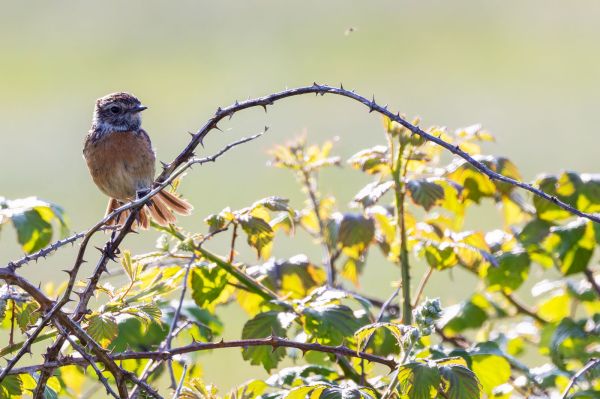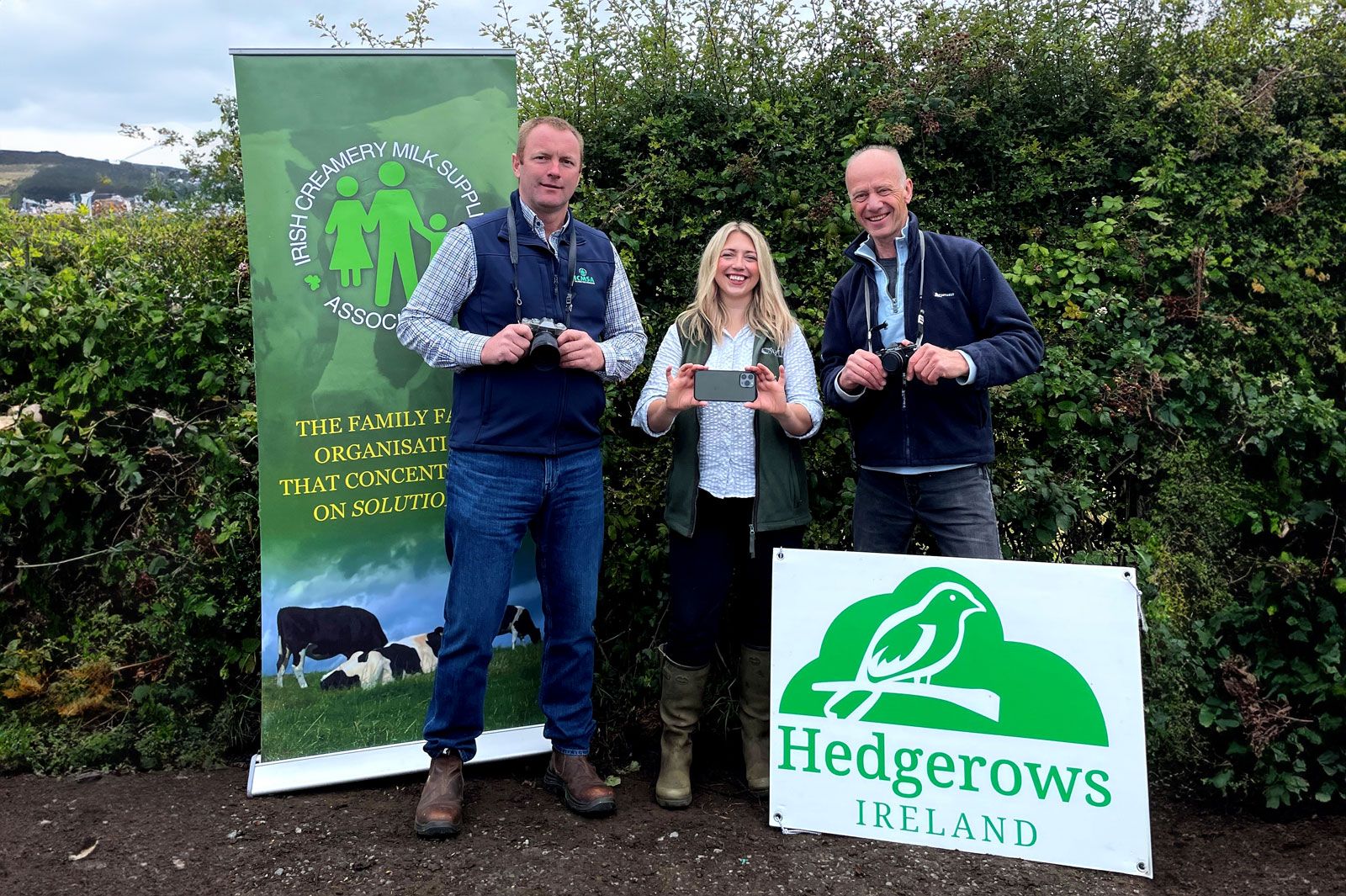Appreciating our hedgerows

There are all sorts of advantages and positives associated with hedgerows that many of us have taken for granted, even forgotten, but that are now becoming more obvious and more important.
Micheál explains that from a biodiversity point of view, Ireland’s hedgerows – of which there are 689,000 kilometres – are vital, as they are a huge source of food for so many different species: “For birds, hedgerows provide shelter and nesting sites and, for the songbirds, like the blackbird, the hedgerow gives them a chance to get up there and call their tunes, most importantly during mating season.
“Some smaller birds use hedgerows as lookout points and screens against predatory birds. It’s really important that we protect our hedgerow heritage going forward.”
Hedgerow week
National Hedgerow Week took place last month and Teagasc held a series of events around the country highlighting the management, maintenance and establishment procedures for hedgerows. From Birr Castle to Moorepark and places in between, the hedgerow demonstrations attracted large turnouts of people – environmentalists, farmers, advisors and contractors. One of the major topics was farmland biodiversity, for which hedgerows are an integral and critical aspect, as Micheál explains: “All the different habitats on Irish farms including grasslands, soils, watercourses, woodland, and hedgerows were highlighted. A novel biodiversity resources pavilion allowed organisations such as Inland Fisheries Ireland, Invasive Alien Species in Ireland, and the All-Ireland Pollinator planning group to be represented and outline their varied roles.
“The importance of the Agri-Climate Rural Environment Scheme (ACRES) was also highlighted in promoting biodiversity in Ireland’s woodlands, hedgerows and landscape, generally. Forestry now must accommodate so much more than just growing trees for economic reasons. Diverse tree species are an integral part of all plantings. Adherence to best practice in forestry management must take account of the Farming for Water programme, the Local Authority Waters Programme (LAWPRO) and other environment regulatory dictates.”

Competition to show ‘beauty and function’ of hedgerows
Hedgerows Ireland, a Tipperary-based environmental group, in conjunction with the Irish Creamery Milk Suppliers Association (ICMSA) have come together to launch a hedgerow photography competition.
The competition is open to the public, is completely free, and will involve submission of a photo that highlights some aspect of our late summer/autumn hedgerows. Alan Moore of Hedgerows Ireland said: “This could be of a length of hedgerow showing off its shape and overall appearance, or a photo of a plant, bird, mammal, insect, or some other feature which illustrates hedgerow wildlife. Your photo could be a composite of different images in one single picture. We are excited to see what catches your eye,” he said.
Partnership
This new venture represents an innovative partnership between an environmental group and the ICMSA with the aim of celebrating the native hedgerows that are one of our most important landscape features, supporting 95 per cent of the wildlife in our farmed countryside, as well as providing a range of other benefits to nature and wildlife. These include shelter, shade, flood and drought reduction, nutrient buffering, and very significant carbon storage. The competition aims to show the beauty and function of the hedgerows that are our most emblematic rural feature.
ICMSA president, Denis Drennan said the association is committed to both the biodiversity-enhancing and heritage aspects of the competition: “The vast majority of farmers are incredibly conscious of their role as guardians of our rural heritage and, in that capacity, we are happy and proud to sponsor this novel and imaginative means of highlighting Ireland’s hedgerows and the vital role they play as a diversity-enhancing habitat,” he said.
Info
Entries should be made via the website: www.hedgerowireland.org.
Entrants must accompany their photos with a title, location, and their own name.
There are two categories: under-18s (parental consent needed); and over-18s.
There will be three prizes in each category: first prize €500; second prize €250; and third prize €125. Entries close on October 31.
Vital biodiversity resource
Micheál provides a practical description of the vital roles of hedgerows in our rural landscape: “Hedgerows in themselves are a biodiverse feature but for the different wild animals on the farm, the hedgerows provide a link or corridor so that they can travel safely. Most animals won’t travel in open ground, but they will travel where they have woodland or hedgerow cover. After some percentage of hedgerow removal in recent decades, the emphasis is now on re-establishment and restoration. How to establish hedgerows and maintain them over the long term was a central theme of the Teagasc-promoted National Hedgerow Week. Working in conjunction with the Heritage Council and the local biodiversity officers, we delivered demonstrations on the importance of hedgerows and their management.
In recent years, many farmers have sown hedges to comply with schemes, but the benefits are far greater than scheme adherence, according to Micheál.
“We often associate hedgerow profiles with the traditional ‘short back and sides’ maintenance protocol. Now, the profiles are changing dramatically with the aim of promoting a 50:50 split between the topped hedge, that is regularly maintained, and the treeline hedge, which is basically established and not topped again. It’s allowed to grow to form a linear woodland.
“Generally, when we’re going out to farms to give recommendations on what to sow, we look at what is already growing and thriving and natural in the area. Not every species is going to work on every farm. The likes of your hawthorn and your holly, for instance, don’t like very wet ground; your blackthorn is more suited there. Around 75 per cent of the hedgerows in Ireland are whitethorn and hawthorn. It’s important to incorporate other species in there, the likes of the gilder rose, the dog rose, the black thorn, holly, spindle, hazel. What we’re recommending is that you don’t have a monoculture hedge, that you have a diverse mix. One of the big things we are promoting, is that even if you are going to have a maintained hedge that’s going to be trimmed, then at least every 50 metres you let one specimen, a whitethorn or hawthorn, for instance, continue to grow up above the hedge so that it will form a tree. That is becoming a requirement under the Nitrates Derogation. If we keep trimming all our hedges too severely, they never get a chance to flower or produce fruit. So if you have your whitethorn plant that can grow up into a tree, when it flowers it’s going to produce nectar with all the benefits for the different pollinators that brings with it. Because they’re allowed go to flower, they’ll bear fruit. So, the ‘haws’ and other fruits are a food source for birds over the winter.”
A multi-storey habitat
Micheál wants to remind farmers that they already possess a great, natural resource: “A lot of farmers don’t fully realise what they have on their farm already. It’s not always a case of putting in something new. Sometimes it’s a case of just changing the management of what’s already there. We recommend that you don’t trim hedgerows below 1.8 meters to allow nesting birds to nest securely from predators including foxes, cats or rats. These birds don’t want to nest at the very top of the hedge either because sparrowhawks or other birds of prey will attack them. They want to live in the centre of the hedge where they’re safe. When hedges are being trimmed, a wider base is preferable to accommodate the safe movement of small animals and birds. We could compare the perfect hedgerow profile to a multi-storey, with room for everyone to be safe.
“Other notable benefits of our hedgerow-rich landscape include the fact that barn owls use them to navigate and pick up mice and other food sources. Our native bats use hedgerows almost as Google Maps. They won’t go directly across the field. They will follow the hedgerow. So, in that regard alone, our hedgerows play a very important role. Generally, people don’t realise the extent of the roles hedgerows play. Like forests and woodlands, hedgerows sequester carbon and have a huge benefit in terms of water quality, by slowing and stopping overground flow of nutrient-rich water run-off.”




